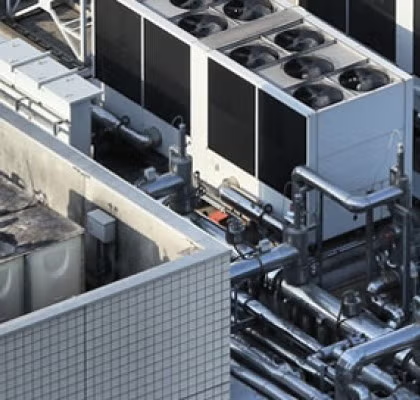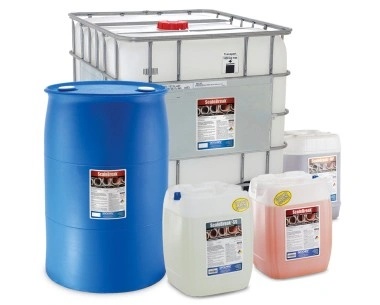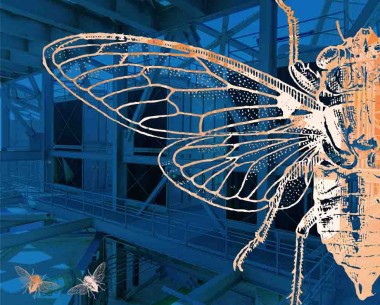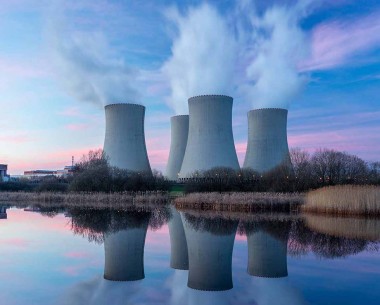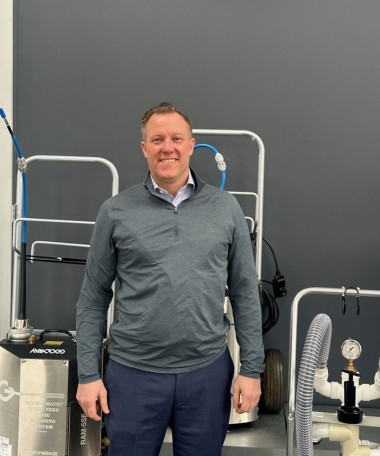New Technology Enhances Cooling Tower Maintenance

Looking Back
The concept of moving air across a water stream to produce a cooling effect did not originate with the first cooling tower. As early as the times of the ancient Egyptians, Romans and Greeks, wet fabric mats were hung in the windows and doorways of dwellings to cool the indoor environment. Wind blowing through the mats evaporated the water thereby cooling the air entering the building. The same technique was later used in the royal palaces of India.
The first ventilation fans were developed in the 1500's and were later combined with the "wet mat" cooling process to create the first rudimentary "cooling towers" in the textile mills of New England in the 1800's. The fans were used to move the water cooled air into the mills making working conditions more pleasant in the summer months. The 1930's saw the introduction of evaporative coolers, known as "swampies" which operate on the same principle as the early mill cooling towers and could cool the air temperature by as much as 10 degrees on days with low relative humidity. This process would eventually evolve into the modern cooling tower.
View Goodway's Cooling Tower Cleaners
Cooling Towers 101
Cooling towers are primarily used to cool water in air conditioning systems. They are also used in process industries to cool materials. This article will concentrate on the air conditioning application of cooling towers.
The warm water returning from the chillers is pumped to the top of the tower and distributed by spray nozzles over a medium known as "fill". The purpose of the fill is to expose as much of the water's surface as possible. As the water drops through the fill, fresh air from outside the cooling tower is forced through the tower. The water, cooled by partial evaporation, then falls into a basin at the bottom and is circulated back to the chiller to start the process all over again.
Most of today's cooling towers are made using the same basic components:
- A pump to bring the water to the top of the tower.
- Spray nozzles to distribute the water over the fill.
- A fan to move outside air through the tower.
- The fill to expose the water surface to the air stream.
- A basin to capture and store the cooled water.
Other components are also used in cooling towers such as float valves, filters, strainers, etc., but these are the basics.
A single cooling tower can be used to supply chilled water to one or several chillers. For each chiller served by the cooling tower, there is a "cell" in the tower. Each cell is independent and has its own fan, fill and basin. Each cell has an access door or panel for entry into the basin. In some older cooling towers, the access opening is under the water level of the basin which requires the basin to be drained before entry. This is not a problem with the vast majority of cooling towers in service today.
Cooling towers come in four main types. They are:
- Induced draft counter flow cooling towers.
- Forced draft counter flow cooling towers.
- Induced draft cross flow cooling towers.
- Forced draft cross flow cooling towers.
In induced draft cooling towers, the fan is mounted at the top of the tower and is used to "pull" air through the tower. In forced draft cooling towers, the fan is mounted on the side of the tower and is used to "push" air through the tower. In counter flow cooling towers, the air enters at the bottom of the tower and travels up in the opposite direction of the water stream. In cross flow cooling towers, the air enters the side of the tower and travels perpendicularly to the water stream. The induced draft counter flow cooling tower is probably the most common. Cooling towers come in all sizes from as small as a minivan to as large as a three story building covering the area of a football field.
Energy Efficiency and the Cooling Tower
Many people overlook the importance of the cooling tower to the overall energy efficiency of a building's cooling system. Chillers use about five times the energy of the cooling tower. Consequently, more attention is paid to the chiller than the cooling tower in most facilities. The reality, however, is that the chiller's efficiency improves with cold condensing water, which comes from the cooling tower. It is estimated that for every degree cooler the water supplied by the cooling tower to the chiller is, chiller efficiency will increase two to three percent.
Several factors can contribute to cooling tower efficiency, including proper sizing of the tower (most cooling towers are undersized to save money), the age of the tower (older towers often degrade over time), using more effective fill materials, using variable frequency drive fan motors and replacing old spray nozzles.
Consider if you will, that a cooling tower is nothing but a great big air washer. The outside air that is drawn into the tower is contaminated with pollutants, dust, pollen, exhaust byproducts, insects and whatever else is suspended in it. As the water falls through the air stream, it captures these contaminants and carries them into the basin. This water, in turn, is delivered to the chiller. As the cooling water is heated in the chiller by absorbing heat from the refrigerant, the contaminants precipitate out of the water and adhere to the chiller tube walls, reducing the efficiency of the chiller. The result of all this is increased energy and maintenance costs.
Heavier contaminants will tend to settle to the bottom of the cooling tower basin creating "dead" areas. These dead areas form a shield between the basin surface and corrosion-preventing chemicals that are added to the water. This leads to under-deposit corrosion of the metal surfaces. Once corrosion begins, blisters form which release oxide particles which add more suspended solids to the condenser water stream. In addition, mud, dirt and debris in the basin provide an ideal environment for microbiological organisms, some of which secrete an acidic solution that can contribute to additional corrosion. Some of these microorganisms represent a health risk to maintenance personnel, and if released from the tower in the form of aerosols present a risk to the general public. Suspended solid accumulation can be minimized by the use of a sidestream filter, often referred to as a sand filter. While these filters can remove some of the suspended solids, they do nothing about the settled debris in the basin. Sidestream filters are not inexpensive, typically priced into the $20,000 to $30,000 range.
It's a Dirty Job That Somebody Has to Do
Having examined the effect a dirty cooling tower has on overall air conditioning system efficiency, it makes sense to keep the cooling tower as clean as possible as well as to perform maintenance on the tower at regular intervals. Unfortunately, until recently, cleaning the cooling tower has been a very labor and time intensive job. First, the cooling tower cell must be shut down and drained completely which means losing all of the water treatment and water down the drain. (To calculate the volume of water in the cell multiply the length by the width by the height of the basin and multiply that result by 7.5. This is the water volume in gallons.) Of course, this means the chiller that the cooling tower cell supplies chilled water to must also be shut down and taken off line. This can be problematic if the cooling demand is high and occupant comfort might be compromised. In situations like this it is not uncommon to schedule tower cleaning after hours leading to overtime costs.
Next, a crew of maintenance workers cleans and inspects the distribution basin and the spray nozzles at the top of the cooling tower, and cleans and inspects the fill. Then the workers have to shovel the bulk of the debris out of the basin. The basin is then washed out using a pressure washer or fire hose. After all cleaning and maintenance is complete, the cell must be refilled and the water treatment chemical balance reestablished. A cell cleaning on an average size cell can take a crew of four workers eight hours to complete. Most cooling tower manufacturers recommend this be done before and after the cooling season, provided there is a cooling season. Cooling towers located in warm climates do not have a cooling "season". Still, the recommendation is to clean two to four times per year. But what if you could clean the cooling tower while it is on line without draining the basin?
Guess What? You can
A new product has recently been introduced to the market that makes it possible to clean a cooling tower while it is on line without draining the basin and losing all the water and treatment chemicals. Goodway Technologies Corporation, Stamford, CT has developed the CTV-1500 Cooling Tower Vacuum. It features an adjustable flow control to allow the operator to clean at the desired recovery rate up to 60 gallons per minute. The unit not only helps to control costly chemical and water waste, but also eliminates the direct handling of dangerous cooling tower bacteria and other microorganisms. This product allows one operator to clean a typical basin in about two hours thereby freeing up other maintenance personnel to perform other critical tower maintenance functions. Many users of the product now clean their cooling towers on line every month to control sediment build up and improve chiller performance.
The unit consists of a motor and pump, a strainer basket to trap larger debris, inlet and outlet hoses, wands, extensions, cleaning tools and a semi-automatic pump priming system. Available cleaning tools include a 20 inch floor brush, a flat paddle tool for getting under the fill, a bulk pick up tool and a 6 inch utility brush making it possible to clean all of the basin surfaces including those hard to reach areas.
The operator simply connects the inlet and outlet hoses using a simple cam lock connector (no tools required). Next, the proper wands and tools are connected with a simple water tight slip fit. The machine is then connected to a standard outlet (the machine draws only 15 amps). The semi-automatic pump priming feature is easy to use and very user friendly. It makes getting started quick every time. The adjustable outlet valve allows the operator to select the desired recovery rate. When basin cleaning is done more frequently, solids do not build up as much and the basin can be cleaned at a lower recovery rate which saves water and chemicals. Self contained and very portable (35" high x 22" wide x 21"deep, 125 pounds), the CTV-1500 is a breeze to move from one cooling tower to another or from one building to another.
Most users do not mind having some of the water and chemical treatment sent down the drain along with the debris, because only between ten and twenty percent of the basin water is lost in the cleaning process. In most cases, the entire basin can be cleaned from outside the tower, making the job even more pleasant. Many workers complain of flue-like symptoms after manually cleaning a cooing tower. There is no need to be concerned about sending the debris down the drain because the dirt and sludge is so fine that there is really no danger of clogging the drain. If you think about it, when you drain the basin or back flush a sidestream filter, it all goes down the drain, too. A simple filtration device is available for users who wish to capture the solids before the water drains or for those who simply cannot or do not wish to lose any water at all.
Here's what Dwayne Bratton, Chief Engineer for Wilcox Realty Group, Dallas, TX and a user of the CTV-1500 has to say. "This vacuum system enables our engineers to schedule predictive maintenance at our facilities during normal operating hours, saving overtime labor fees and reducing HVAC down time, which is critical in a 24 x 7 operation such as we maintain."
Learn How Our New Product Streamlined Cooling Tower Cleaning
One Final Word
We all know that with today's energy costs and the vulnerabilities of the power grid, it is in every maintenance professionals' interest to operate as efficiently as possible. Maintaining a clean cooling tower results in colder chilled water being delivered to the chiller increasing the efficiency of the chiller and making chiller tube cleaning easier. America will never run out of electricity, but it is vitally important for us all to do our best to conserve energy. Economically it just makes sense. So, everybody, let's keep those cooling towers clean.

